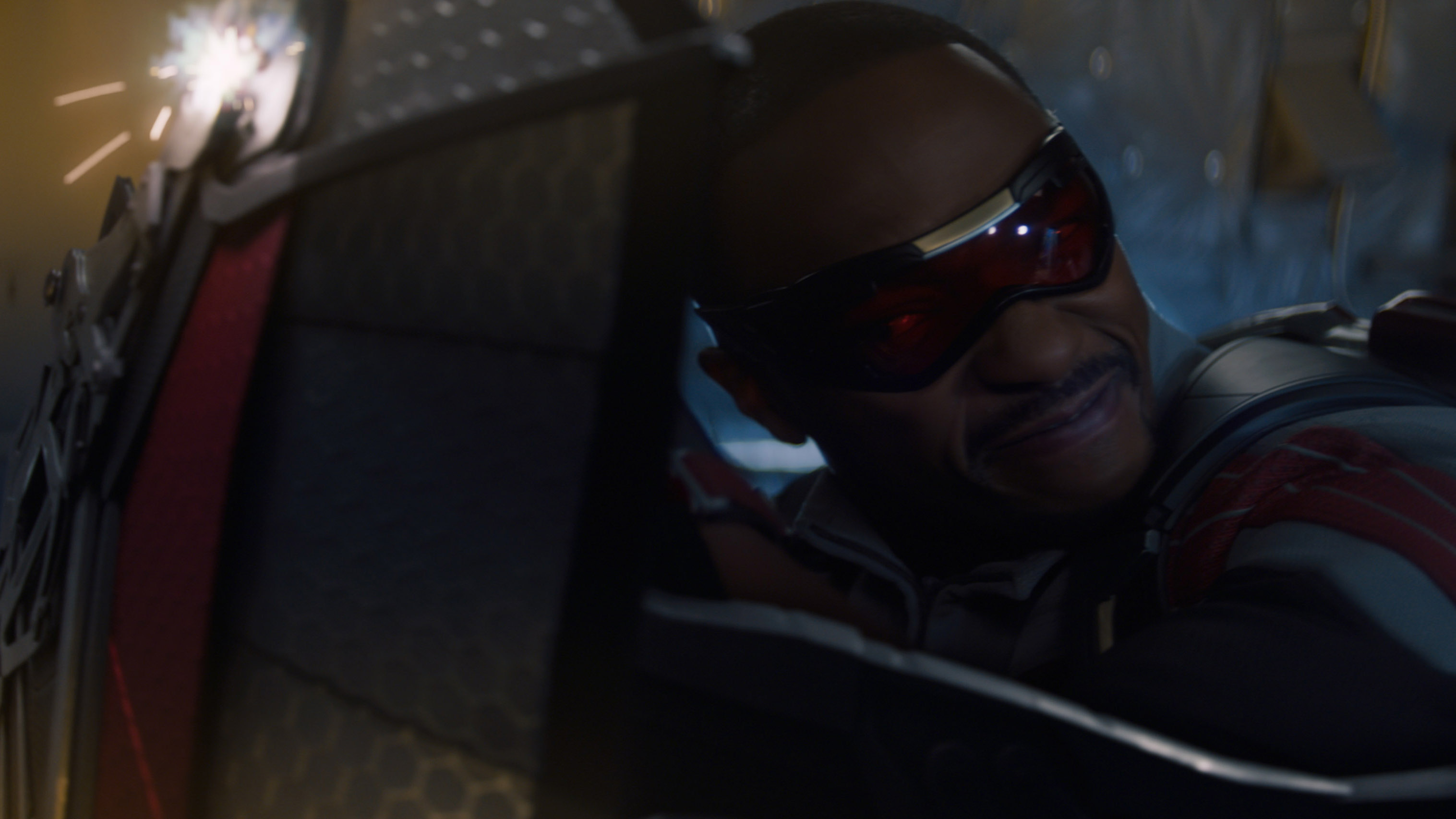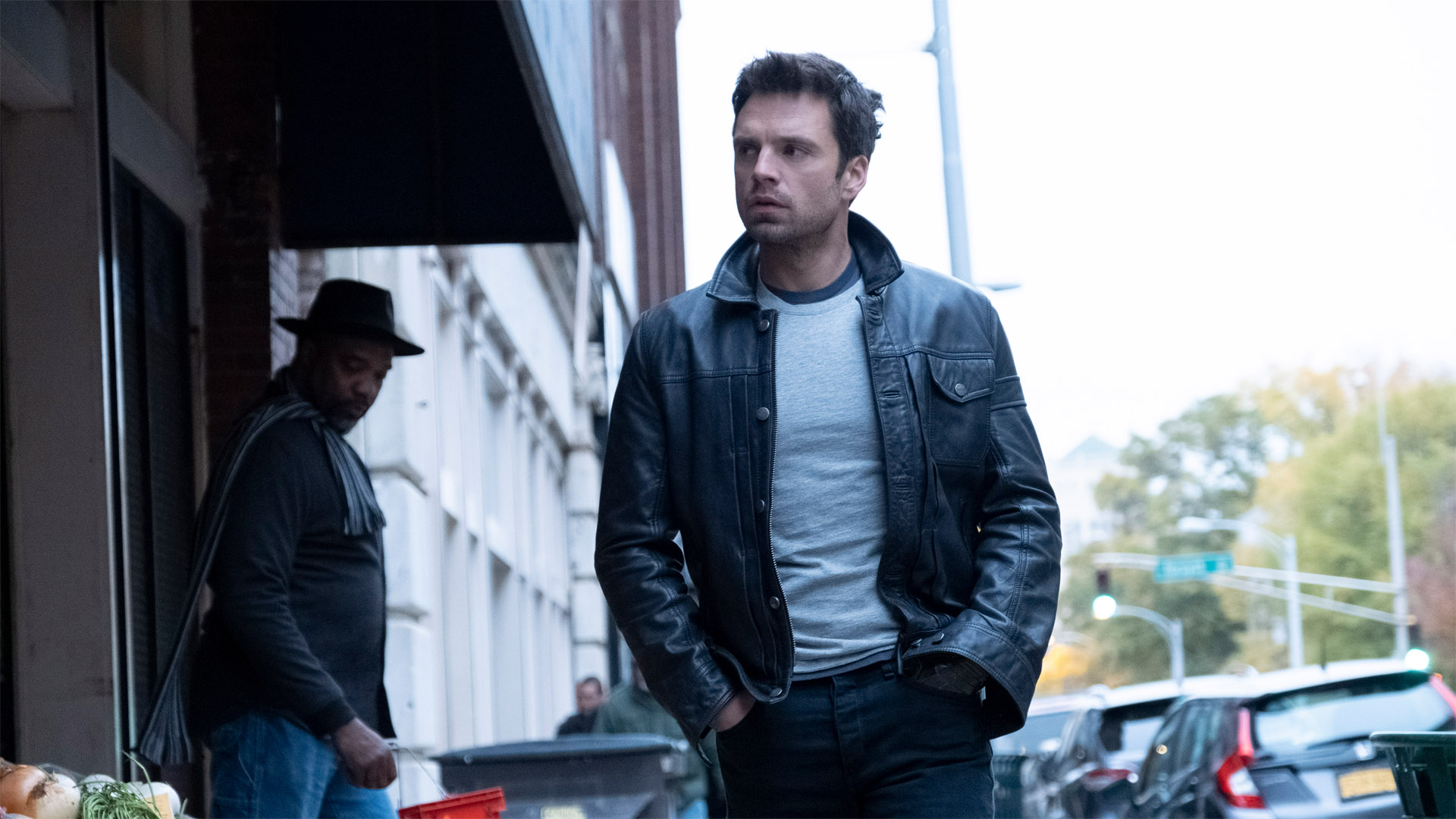The Falcon and the Winter Soldier episode 1 recap: great opening, but slow overall
Huge spoilers ahead

- Episode 1 (of 6), 'New World Order'
- Written by Malcolm Spellman
- Directed by Kari Skogland
★★★
Spoilers for the first episode of The Falcon and the Winter Soldier follow. Watch it first before reading this.
Just two weeks after the WandaVision finale wrapped up a bizarre but compelling exploration of grief, Disney Plus returns to the Marvel Cinematic Universe with a very different proposition. With no sitcoms, no magic and no playing around with aspect ratios, The Falcon and the Winter Soldier takes us back to the more serious, techno-thriller end of the MCU spectrum. There are no winks to the camera and the superhuman activities are kept to a bare minimum.
And while Captain America has left the Avengers behind, his presence looms large. The Falcon and the Winter Soldier opens with Falcon, aka Sam Wilson, staring at the famous shield Steve Rogers gave him during the final scenes of Endgame. “How does it feel?” asks Rogers in flashback. “Like it’s someone else’s,” Sam replies. It’s a symbol that weighs heavily on its new owner throughout the episode.
There’s little time to dwell on its meaning, however, as we’re immediately transported into 007 territory for the sort of action sequence you’d expect to see before the credits of a Bond movie. Falcon’s mission involves rescuing a military liaison named Captain Vasant from a terrorist organisation known as the LAF – the group’s leader is Georges Batroc, a character with MCU history. The trouble is, they’re in a plane over Tunisian airspace – an area where the US military can’t be seen to operate – so Falcon has to spread his wings for an audacious aerial mission to recover Vasant before he reaches the Libyan border.
- New Captain America in The Falcon and the Winter Soldier explained
- How to watch the Marvel movies in order
- Flag Smashers in The Falcon and the Winter Soldier explained
It’s an utterly exhilarating set-piece featuring breathtaking leaps from planes and helicopters, wing-suited bad guys, and daredevil chases through spectacular desert canyons so narrow that they clip Wilson’s wings. The battle ends with an ingenious move from Falcon as he pilots himself through an open helicopter, grabs Vasant and leads a bunch of missiles into Batroc’s helicopter – though the bad guy does manage to escape.
It’s debatable whether anything of this scale has ever been attempted on TV before, an eight-minute aerial battle that competes with Game of Thrones’ most epic moments for scale, ambition and spectacle. When Marvel said this six-part season had movie-level production values, they weren’t exaggerating.
Back on the ground, Sam shares a drink with military intelligence officer Lt Torres, as he repairs his friendly, Redwing. Torres explains that LAF crews are taking advantage of post-Blip chaos to make money, but that he’s more concerned about another organization known as the Flag Smashers.
Get daily insight, inspiration and deals in your inbox
Sign up for breaking news, reviews, opinion, top tech deals, and more.
They use red hands painted on walls (which are only detectable with a smartphone) as a calling card, and think the world was a better place before the billions who disappeared from existence came back. Sam tells him to let him know if he needs any help dealing with the new group, but Torres seems more preoccupied with finding out what happened to Steve Rogers – various conspiracy theorists are even speculating Cap’s taken up residence on the Moon.

Sam returns to Washington, DC, to present Cap’s shield to go on permanent display at the Smithsonian. Celebrating his friend, he explains that his strengths went way beyond the fact that he’d “mastered posing stoically” – he was a true hero. He goes on to say that symbols are nothing without the men and women who give them meaning, and even though the shield is incredibly powerful totem, “it’s more about the man who propped it up.” He thinks now is the time to look to the future and for new heroes for these post-Blip times.
James 'War Machine' Rhodes is attending the meeting in his US military capacity, and grabs Sam for a chat. He asks why he didn’t take on the mantle of Captain America when Rogers asked him. Sam still feels that shield belongs to someone else, but as Rhodey reminds him, the world is very different now.
It’s a quarter of an hour into the episode and we’re yet to see or hear anything from the Winter Soldier half of the show’s title. That’s rapidly redressed in a fancy European hotel, as the Winter Soldier (still conspicuously employed by HYDRA) launches a vicious, clinical attack on numerous hotel guests. Like the earlier aerial battle, its hand-to-hand combat that would feel right at home in a movie – until the sequence is interrupted by Bucky Barnes waking up in his psychiatrist’s office.
She asks if he’s still having nightmares, but he denies that he is. He’s clearly reluctant to continue with therapy, but the sessions are a condition of the pardon for his crimes – this is convenient for future Marvel stories, seeing as Bucky was one of the most wanted men in the MCU. He tells her that he’s just crossed a line off his “list of amends”, actions he’s atoning for from his time as the Winter Soldier. This particular line was Senator Atwood, a HYDRA pawn he helped into office.
The psychiatrist asks if Bucky broke any of his three rules to do it – he’s not allowed to do anything illegal or to hurt anyone, and he must remember that he’s no longer the Winter Soldier. However, he managed to get her apprehended by the law, without transgressing any of the guidelines.
You get the sense, though, that ticking off these names is the only thing keeping Bucky going. A man out of time, he has no family, no history, and is struggling to make friends – there are only 10 numbers in his phone, and he’s not returning Sam Wilson’s texts. He says the only time he’s felt peace is the short period he spent in Wakanda before Thanos paid a visit.
Back on his home turf of Brooklyn, Bucky meets his elderly friend, Yori Nakajima, for lunch. Yori suggests he ask the waitress, Leah, out on a date, “maybe to bingo or a night of pinochle”. She agrees to meet him the next evening – which concerns Bucky, seeing as he hasn’t danced since 1943. And it’s an intriguing idea that Bucky, a 106-year-old man in the body of a 30-something, should be drawn to spend time with an old man such as Yori. In terms of pop culture references and formative years, they should have a lot more in common.

The scene also starts to tie into the Winter Soldier’s hotel raid. Yori’s son was killed on a business trip, and he’s never been able to find out why – all he knows is that he was in the wrong place at the wrong time. It’s only later on, when Bucky bails on his Battleship-themed date to pay a late-night visit on Yori, that we learn the true extent of their connection.
He sees a photo of Yori’s dead son – one of the victims he executed in the hotel that fateful night. He looks at his “list of amends” and sees Nakajima’s name at the top. If Bucky didn’t already know it’s a hell of a coincidence – though it does show the extreme psychological impact of the years he spent under HYDRA’s influence as the Winter Soldier.
During some downtime, Sam heads back to his home in Louisiana to meet up with his sister, Sarah, and her two sons. She runs a seafood business, but fell on hard times during the five years half the world was dusted. To help make ends meet, she wants to sell the boat – the Paul & Darlene – that belonged to their parents, but Sam isn’t so keen on parting with a vessel that was a huge part of their childhood. He suggests they pay a visit to the bank to get a loan – not that Sarah hasn’t tried.
Unfortunately, the bank manager is less keen on helping them out than getting selfies with an Avenger. It turns out that when you’ve been away for five years, not even having helped save the world from Thanos counts towards your credit score. It’s this – and other implications of the Blip – that are the standout character elements of an episode that’s occasionally a bit too talky and slow.
While WandaVision made several references to the sudden return of billions of people – not least the death of Monica Rambeau’s mother in the interim – the fact that it was set in a town cut off from the rest of the world insulated us from the full impact of the Blip. It’s already clear, however, that the MCU’s ‘New World Order’ is going to be a key part of the fabric of The Falcon and the Winter Soldier. As Rhodey put it eariier, the “world is broken”, with no stability and allies turned into enemies.
The implication is clear – saving the planet from a crazed alien warlord doesn’t fix the world’s problems overnight. Indeed, the parallels with the coronavirus crisis, as the world comes to terms with a new normal, are impossible to ignore – even if the show was written and shot long before the pandemic.
Aside from that pre-credits sequence, antagonists are conspicuous by their absence until fairly late in the episode, but we do get to see the Flag Smashers Torres teased earlier – though unlike WandaVision, The Falcon and the Winter Soldier doesn’t introduce its villains with a catchy theme tune. Instead we see Torres investigating the group in Switzerland, and getting caught up in a cross between a flash mob, a heist and an Anonymous protest. He’s incapacitated by a masked, seemingly superpowered assailant – though he walks away with minimal injuries.
Torres calls Sam to show him what happened, but Sarah interrupts to show her brother a TV broadcast covering an announcement from the government official from the Smithsonian. The government has taken Sam’s declaration that America needs another hero to heart, and unveils a brand-new Captain America.
Shield or no shield, those are some big shoes to fill.

Recall what happened in Westview with our recaps of WandaVision episode 1, WandaVision episode 2, WandaVision episode 3, WandaVision episode 4, WandaVision episode 5, WandaVision episode 6, WandaVision episode 7, WandaVision episode 8 and WandaVision episode 9.

Verdict:
Despite a barnstorming opening sequence that would feel totally at home in the biggest of big-screen blockbusters, the first episode of Marvel’s latest TV show never quite catches fire.
It’s not helped by the fact it feels like The Falcon or the Winter Soldier, with the two leads kept separate throughout, following stories that – for the moment, at least – feel totally separate from the Flag Smashers who are being positioned as the Big Bads. While important to character development, Sam and Bucky's personal stories aren't great for the show's momentum – particularly this early in the run.
Even so, it feels like a worthy continuation of the more grounded, espionage-driven branch of the MCU established by Captain America: The Winter Soldier. The implications of a post-Blip world-building are also intriguing. All the pieces are in place – now we just need a brilliant second episode to explode the show into life.

Marvel-ous facts
- This Sam Wilson has big doubts over assuming the Captain America mantle, but the character did inherit the role from Steve Rogers in the Marvel comics, in All-New Captain America #1 (2014).
- The conversation between Sam and Steve Rogers about Cap’s shield is taken from the end of Avengers: Endgame.
- Sam reveals that he’s been working for the Air Force for six months. Seeing as he was one of the billions of people dusted by ‘the Blip’, Captain America and the Winter Soldier is set at least six months after Avengers: Endgame. The events of WandaVision are also old news to Sam and Bucky.
- In the Marvel comics, Sam’s flying sidekick Redwing is an actual living, breathing falcon. A modified Stark Industries drone, the electronic Redwing made its first screen appearance in Captain America: Civil War.
- The way Sam uses his “wings of steel” to protect himself from bullets is reminiscent of ’60s cartoon show Batfink.
- Did you recognize the leader of the LAF terrorist group? Georges Batroc (played by Georges St-Pierre) appeared as a minor villain in Captain America: The Winter Soldier, as part of a covert hijacking sting arranged by Nick Fury. Batroc the Leaper made his comic-book debut in Tales of Suspense #75 in 1966.
- This isn’t the first time we’ve visited the Captain America exhibit at the Smithsonian in Washington, DC – it’s an important location in Captain America: The Winter Soldier. Cap breaks in to ‘borrow’ his World War 2 uniform, under the watchful eye of a security guard played by none other than Stan Lee.
- In case you’re wondering, the “pinochle” mentioned by Yori is a card game.
- The Wilsons’ boat is named after their late parents, Paul & Darlene. These are also the names of Sam’s mom and dad in the comics, though they lived in New York rather than Louisiana. They both died when Sam was in his teens. Sam’s sister, Sarah, also shares her name with her comic book counterpart.
- Does Anthony Mackie get extra points for mentioning the brand name when he says "you gotta Marvel at it"? (He's referring to the boat.)
- The Flag Smashers – the anarchic terrorist organisation who believe the world was better during the Blip, and want a world with no borders – take their name from a comic-book villain called Flag-Smasher.
- The woman handing out masks to the assembled Flag Smashers in Switzerland is particularly important. Played by Erin Kellyman (Enfys Nest in Solo: A Star Wars Story), the character’s name is Karli Morgenthau. Karl Morgenthau was the original Flag-Smasher in the comics, the son of a Swiss banker who fought to destroy international borders. It looks like Karli will be the MCU’s take on the character.
- Fresh from a few cameos in WandaVision, WHIH (the fictional MCU news network that made its first appearance in promos for Ant-Man) broadcasts a story about the unveiling of the new Captain America.
- The new Captain America revealed at the end of the episode is played by Wyatt Russell, son of Kurt Russell and Goldie Hawn. The credits reveal the character’s actually called John Walker, a name with history in Marvel Comics. Created by Mark Gruenwald and Paul Neary in 1986, Walker made his first appearance as Super-Patriot, a villain who was as patriotic as Steve Rogers, but not quite so idealistic. He later became the actual Captain America before adopting the alias of US Agent.
- The Falcon and the Wilson Soldier’s main composer, Henry Jackman, also scored Captain America movies The Winter Soldier and Civil War.
New episodes of The Falcon and the Winter Soldier are available on Disney Plus every Friday.
Richard is a freelance journalist specialising in movies and TV, primarily of the sci-fi and fantasy variety. An early encounter with a certain galaxy far, far away started a lifelong love affair with outer space, and these days Richard's happiest geeking out about Star Wars, Star Trek, Marvel and other long-running pop culture franchises. In a previous life he was editor of legendary sci-fi and fantasy magazine SFX, where he got to interview many of the biggest names in the business – though he'll always have a soft spot for Jeff Goldblum who (somewhat bizarrely) thought Richard's name was Winter.
